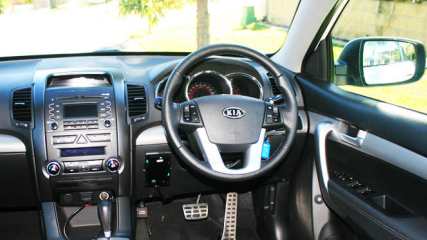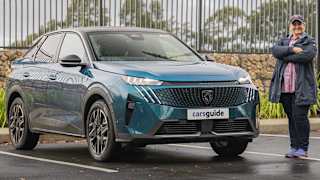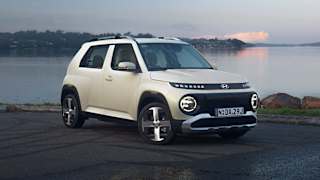Hyundai Santa Fe vs Kia Sorento 2010 Review
By Mark Hinchcliffe · 15 Apr 2010
Take two Korean twins into the Australian bush and you could have trouble telling them apart. That's what happened when we took loaded up a Kia Sorento and a Hyundai Santa Fe to the gunwales with people and camping gear and headed into the bush to Queensland's majestic Carnarvon Gorge.Our test vehicles were both top-spec diesel models, just the type of vehicle a grey nomad are considering for their lap of the continent.After more than 2000km of highway, country road and limited dirt and offroad driving, we had a hard time telling them apart. They look, feel and even sound similar. Making a buying choice could be even more difficult. Far from being out of their depth in the Aussie bush, these Korean softroaders excel with a quiet, comfortable ride and performance levels that will challenge the average Aussie's view of what it takes to get around west of the Great Divide.The Koreans are forging ahead with Hyundai not far behind Ford, even outselling them in February. Hyundai's sister company, Kia, is a long way back, but surging past Mercedes-Benz and BMW and not far behind Suzuki. Their keys to success are not cheap and cheerful vehicles, but reliable, quality products.What are the differences?The Santa Fe and Sorento are basically built off the same platform with the same underpinnings, shared engineering and engines. On several occasions during the test, I forgot which vehicle I was driving, so similar are the controls and appearance, especially inside.Outside, there is more difference. Voting on the most stylish was divided among friends and family with some preferring the bulkier and more noble look of the Hyundai and others admiring the sleeker Kia with its extra touches of chrome bling.The differences are basically an optical illusion as the silhouettes are almost identical. Kia has made their SUV appear sleeker and slimmer by having higher black plastic mouldings which reduce the amount of painted panels. By comparison the Hyundai looks a little saggy in the rear end. Interiors are also fairly similar and you could easily step from one to the other and operate all the controls and audio functions without having to look.EquipmentBoth have a load of creature features fitted: six airbags, rear parking sensors, cruise control, climate air and leather steering wheel. One of the best features of the two vehicles is the reversing camera screen in the rearview mirror, which is the first place you look when reversing.And how about those electric front seats. They move forward, back, up and down, tilt and have adjustable lumbar support - more positions than the Kama Sutra.The interior differences are few and far between, but could be crucial in making a buying decision. For example if you have rowdy kids, you might want to go for the Hyundai which has a clever convex mirror under the standard rearview mirror which allows parents to check on who started the latest fight.If you have a lot of MP3 players, mobile phones, portable fridges etc, you also might like to buy the Hyundai as it has four 12V outlets compared with two in the Kia.The Hyundai also has an airconditioning vent in the centre console which acts as a chill box. The console has a two-stage lid which helps keep some items separate. However, the Kia has a bigger bin with a small removable inner small bin inside.Both have good build quality inside and while the plastics are a bit hard in places, the Hyundai has slightly better feel on the steering wheel. Its leather seats are also just a shade softer, but neither is particularly plush against your backside.The Kia brings a little bling inside with nice touches of chrome and the word "Sorento" in the door kicker which lights up. It's a slightly more upmarket feel in the cabin. Instruments are near identical except that the Hyundai lights up in blue and the Kia in red. Both have three rows of seats and separate airconditioning controls for the passengers and even the supplied iPod cable will work in either vehicle. So a buying decision could come down to your favourite colour.DrivingIn driving dynamics there is even less of a divide. They both steer slightly lightly around the centre and have an initial tip in the body on turn-in, but don't wallow or lean too much more under heavy cornering.Brake pedals have a plush feel, but deliver similar strong stopping performance even when packed and on loose surfaces. Tyre noise and grip is similar despite the Hyundai running Khumo 235/60R18 tyres and Kia on Nexen 235/60R18 rubber. The diesel engines are the same and have identical power and torque figures, pulling surprisingly well up some steep Central Highlands inclines.Both have a slight turbo lag off idle, but then the power then comes on hot and strong, sometimes giving a bit of a tug on the steering wheel and sending the outside wheel for a short spin until the stability control cuts in if you are on loose or slippery surface. I had previously found the Hyundai engine noise a little intrusive, but once settled into the rhythm of the highway, it was not a problem and no louder than the Kia.While both have capable off-road drive components with electronic locking diffs, slightly more serious off-roaders who like to tackle steep descents may consider the Kia which has a hill descent selector.Over a week of bush driving, both diesel vehicles returned identical fuel econmomy figures of eight litres per 100km. That was the same figure I obtained from the Santa Fe over a week of purely urban duties. The extra load and off-road duties obviously offsetting the highway cruise.So if you are making a choice between these two capable Korean SUVs it might come down to the flip of a coin or your favourite colour. Either way, you shouldn't be disappointed.Hyundai Santa Fe vs Kia SorentoPRICES: $48,490 (Santa Fe Highlander), $48,990 (Sorento Platinum)ENGINES: 2.2-litre turbo dieselPOWER: 145kWTORQUE: 436NmTRANSMISSION: 6-speed autoFUEL TANK: 70 litresTOWING: 2000kg (braked)KERB WEIGHT: 1988kg (Hyundai), 1959kg (Kia)SAFETY: stability control, six airbags and 5-star crash rating










